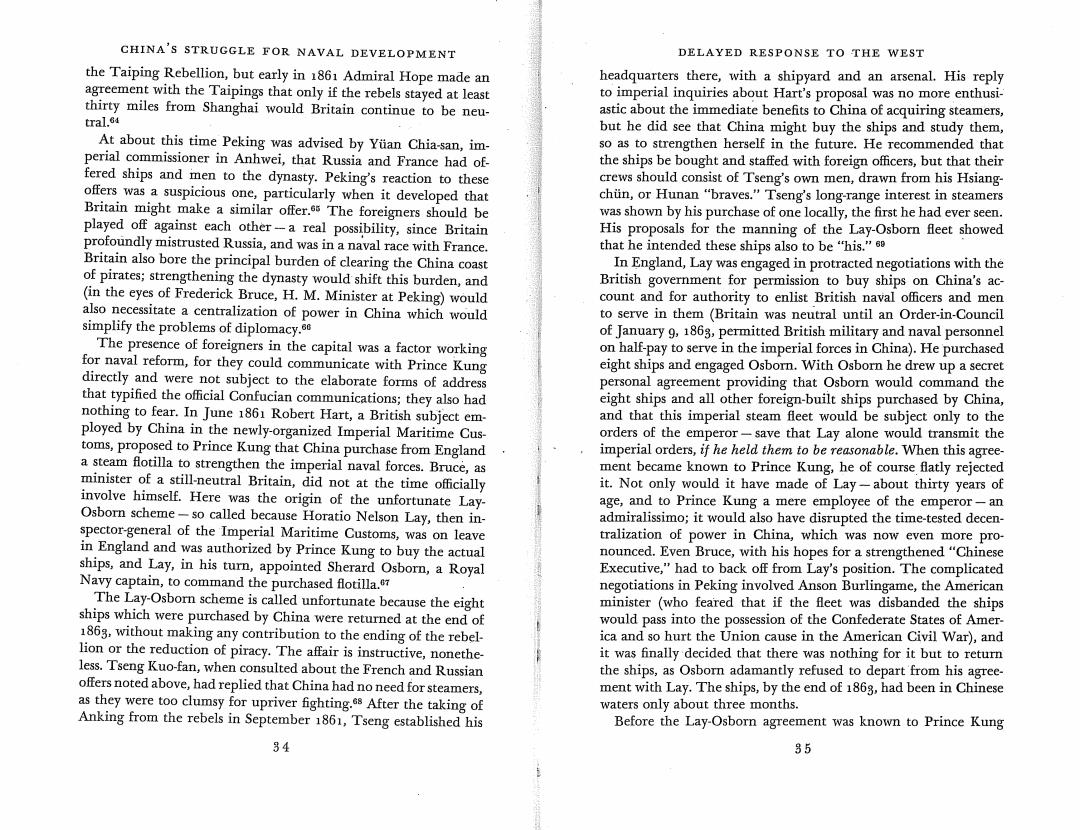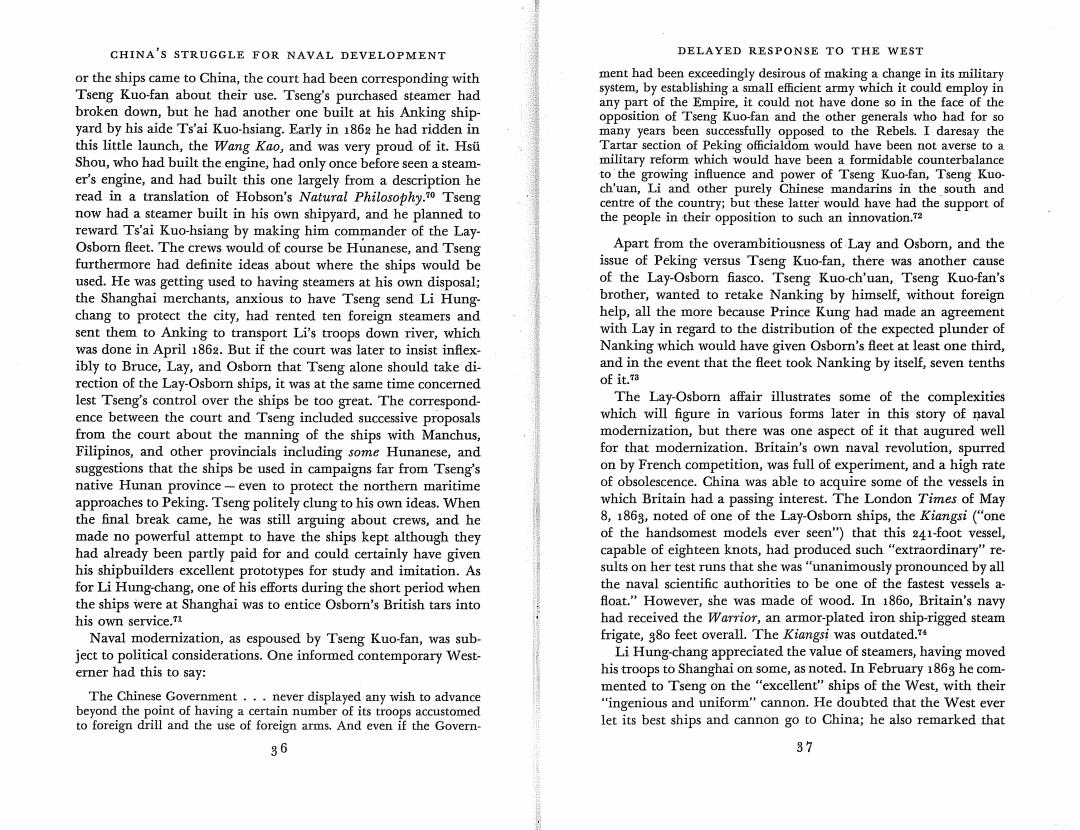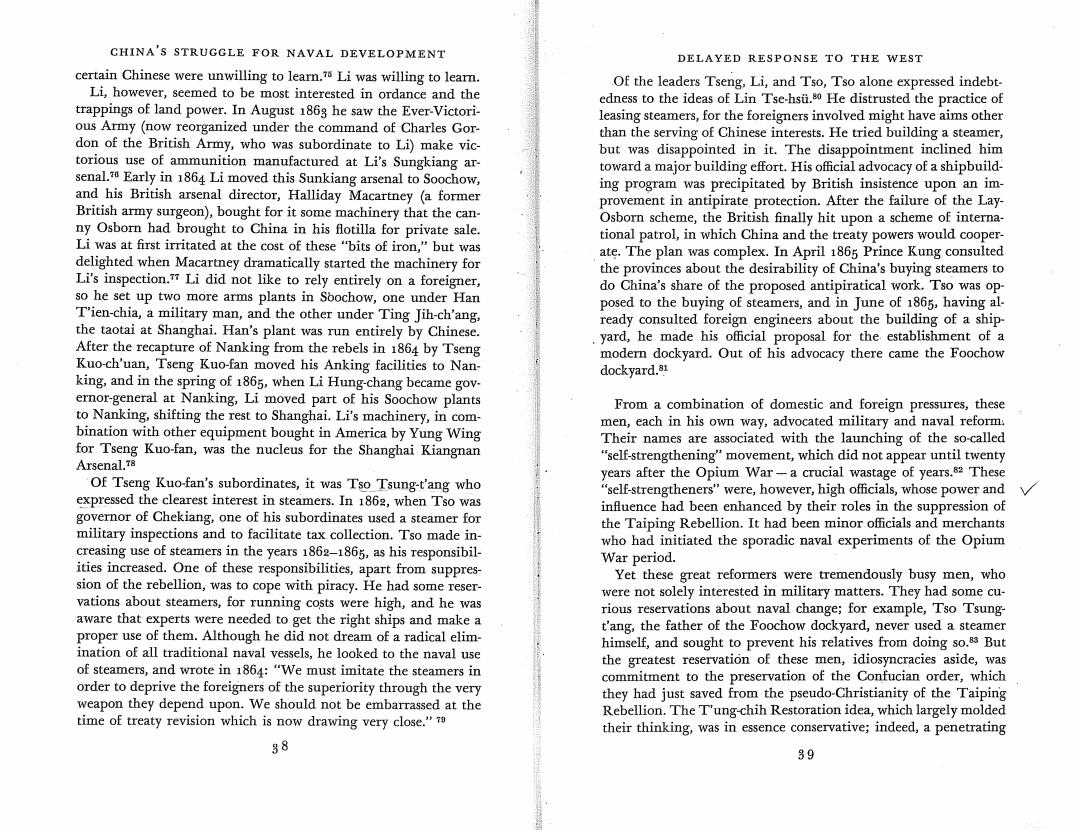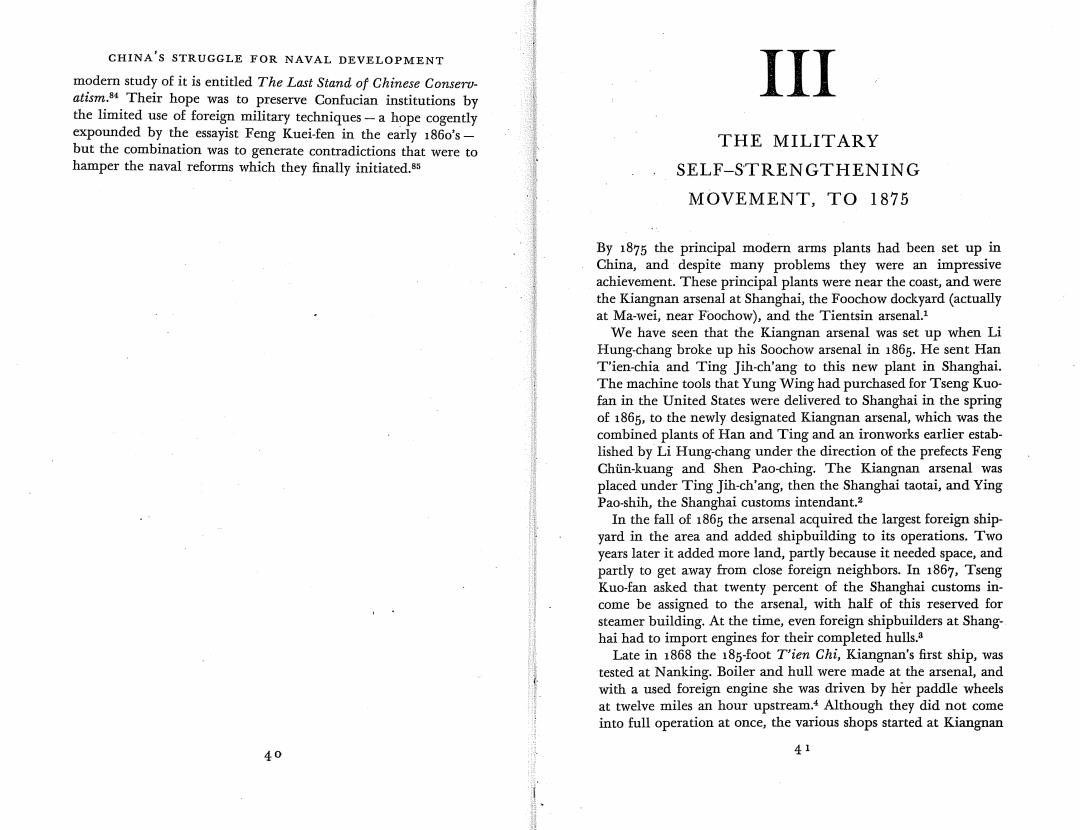
CHINA'S STRUGGLE FOR NAVAL DEVELOPMENT DELAYED RESPONSE TO THE WEST 20,000 men.They retook the Taku forts from the rear.The led the Grand Council and also the new Tsungli Yamen,which British used the built-up,rifled Armstrong naval gun for the latter office,although a temporary concession in Manchu eyes,was first time in this engagement.Chinese ordnance was varied.Some a kind of foreign office to meet Western demands for proper diplo- of the captured guns had been taken from the Plover,Lee,and matic relations.In fact,the Tsungli Yamen lasted past the turn of Cormorant.Some guns were of brass,in some cases double- the century,and came to be involved in reforms which included mounted on strong wooden carriages"after the fashion of double- naval innovation.61 barrelled fowling pieces,"in the words of a British report.Other Changes in the pattern of the Taiping Rebellion were also im- guns were made "of wood,bound round with leather,hooped portant in this concatenation of events.After 1860 the rebellion with iron."The invaders also found a kind of land mine,made reached into the lower Yangtze valley,where foreign ships were of a thirteen-inch shell and a trip-string.There was stiff resistance better known.The dynasty also perforce relied more on the ef- on the land as the allies advanced to Peking,but it gave way, forts of Chinese officials to defeat the rebels,since Manchu forces and the Tientsin treaties were forcibly ratified in the capital had proved to be worthless.92 Tseng Kuo-fan,who since the early itself (after the looting and destruction of the Summer Palace 1850's had been forming,training,and using his personally-or- by the allies)in the summer of 1860.90 Save for the fact that the ganized Hunan militia force,was in 1860 made governor-general final action took place in the capital,and that China scored one of Kiangnan and Kiangsi and imperial commissioner for the sup signal victory,the Second China War was substantially only a pression of the Taipings in all of South China.This linkage of re-enactment of the Opium War,so far as the student of China's formal central appointment with significant regional military naval response is concerned. power was what the dynasty had long sought to avoid.Tseng sent subordinates into certain areas to pacify them.These appoint- That some Chinese and Manchu leaders in the 186o's began ments by him were confirmed by substantive appointments by the to think of naval modernization,and that their proposals were throne.Thus,early in 1863 Tso Tsung-t'ang was appointed gov- implemented,was the product of a fortuitous concatenation of ernor of Chekiang,and shortly became Min-Che governor-gen- domestic and foreign pressures,changes in court leadership, eral.By this time,Li Hung-chang,another of Tseng's lieutenants, and changes in the pattern of relationship between certain pro- was acting governor of Kiangsu.These three loyal Chinese officials vincial officials and the court. symbolized the so-called T'ung-chih Restoration,which sought to The West had finally succeeded in breaking down the tribute revive the dynasty after the devastating Taiping attack-a re- mechanism whereby aliens had been kept on China's periphery vival which had supposed historical precedents,and so had pro- in a few trading centers and admitted to the capital only under found ideological as well as practical concomitants.Each of the an ancient ritual with its kowtow,which clearly marked the three men commanded armies,and enjoyed a power usually not visitors as subordinates.The Tientsin treaties gave further ad- exercised by provincial leaders.Each,after his individual fashion, vantages to the west;they provided for the residence of foreign came to advocate reform,including naval and military reform. ministers in Peking,for many more treaty ports,and for the In the early 186o's,a complicated political situation,which in- opening of the interior to foreign travel and the propagation of volved foreign and native interests,developed at Shanghai.Trade Christianity.The approach of the allied forces to Peking had continued at the port,with important revenues and profits.When caused the Hsien-feng Emperor to fee and hastened his death; the Taiping rebels in 1860 started to fight in the lower Yangtze, this in turn led to the coup d'dtat of 1861 that ushered in the the Chinese at Shanghai had already organized a volunteer mer- reign of the T'ung-chih Emperor,who was controlled by a rela- cenary force,the so-called "Ever-Victorious Army,"commanded tively progressive group of Manchus,most notably Prince Kung, by F.T.Ward,an adventurous American who had been an officer half-brother of the deceased Hsien-feng Emperor.Prince Kung on the Confucius.Britain was officially neutral with regard to 32 39

CHINA'S STRUGGLE FOR NAVAL DEVELOPMENT DELAYED RESPONSE TO THE WEST the Taiping Rebellion,but early in 1861 Admiral Hope made an headquarters there,with a shipyard and an arsenal.His reply agreement with the Taipings that only if the rebels stayed at least to imperial inquiries about Hart's proposal was no more enthusi thirty miles from Shanghai would Britain continue to be neu- astic about the immediate benefits to China of acquiring steamers, tral.64 but he did see that China might buy the ships and study them, At about this time Peking was advised by Yuian Chia-san,im- so as to strengthen herself in the future.He recommended that perial commissioner in Anhwei,that Russia and France had of- the ships be bought and staffed with foreign officers,but that their fered ships and men to the dynasty.Peking's reaction to these crews should consist of Tseng's own men,drawn from his Hsiang- offers was a suspicious one,particularly when it developed that chiin,or Hunan "braves."Tseng's long-range interest in steamers Britain might make a similar offer.5 The foreigners should be was shown by his purchase of one locally,the first he had ever seen. played off against each other-a real possibility,since Britain His proposals for the manning of the Lay-Osborn fleet showed profoundly mistrusted Russia,and was in a naval race with France. that he intended these ships also to be "his."60 Britain also bore the principal burden of clearing the China coast In England,Lay was engaged in protracted negotiations with the of pirates;strengthening the dynasty would shift this burden,and British government for permission to buy ships on China's ac- (in the eyes of Frederick Bruce,H.M.Minister at Peking)would count and for authority to enlist British naval officers and men also necessitate a centralization of power in China which would to serve in them (Britain was neutral until an Order-in-Council simplify the problems of diplomacy.s0 of January 9,1863,permitted British military and naval personnel The presence of foreigners in the capital was a factor working on half-pay to serve in the imperial forces in China).He purchased for naval reform,for they could communicate with Prince Kung eight ships and engaged Osborn.With Osborn he drew up a secret directly and were not subject to the elaborate forms of address personal agreement providing that Osborn would command the that typified the official Confucian communications;they also had eight ships and all other foreign-built ships purchased by China, nothing to fear.In June 1861 Robert Hart,a British subject em- and that this imperial steam fleet would be subject only to the ployed by China in the newly-organized Imperial Maritime Cus- orders of the emperor-save that Lay alone would transmit the toms,proposed to Prince Kung that China purchase from England imperial orders,if he held them to be reasonable.When this agree- a steam flotilla to strengthen the imperial naval forces.Bruce,as ment became known to Prince Kung,he of course flatly rejected minister of a still-neutral Britain,did not at the time officially it.Not only would it have made of Lay-about thirty years of involve himself.Here was the origin of the unfortunate Lay- age,and to Prince Kung a mere employee of the emperor-an Osborn scheme-so called because Horatio Nelson Lay,then in- admiralissimo;it would also have disrupted the time-tested decen- spector-general of the Imperial Maritime Customs,was on leave tralization of power in China,which was now even more pro- in England and was authorized by Prince Kung to buy the actual nounced.Even Bruce,with his hopes for a strengthened "Chinese ships,and Lay,in his turn,appointed Sherard Osborn,a Royal Executive,"had to back off from Lay's position.The complicated Navy captain,to command the purchased flotilla.7 negotiations in Peking involved Anson Burlingame,the American The Lay-Osborn scheme is called unfortunate because the eight minister (who feared that if the fleet was disbanded the ships ships which were purchased by China were returned at the end of would pass into the possession of the Confederate States of Amer- 1863,without making any contribution to the ending of the rebel- ica and so hurt the Union cause in the American Civil War),and lion or the reduction of piracy.The affair is instructive,nonethe- it was finally decided that there was nothing for it but to return less.Tseng Kuo-fan,when consulted about the French and Russian the ships,as Osborn adamantly refused to depart from his agree- offers noted above,had replied that China had no need for steamers, ment with Lay.The ships,by the end of 1868,had been in Chinese as they were too clumsy for upriver fighting.s After the taking of waters only about three months. Anking from the rebels in September 1861,Tseng established his Before the Lay-Osborn agreement was known to Prince Kung 84 95

CHINA'S STRUGGLE FOR NAVAL DEVELOPMENT DELAYED RESPONSE TO THE WEST or the ships came to China,the court had been corresponding with ment had been exceedingly desirous of making a change in its military Tseng Kuo-fan about their use.Tseng's purchased steamer had system,by establishing a small efficient army which it could employ in broken down,but he had another one built at his Anking ship- any part of the Empire,it could not have done so in the face of the opposition of Tseng Kuo-fan and the other generals who had for so yard by his aide Ts'ai Kuo-hsiang.Early in 1862 he had ridden in many years been successfully opposed to the Rebels.I daresay the this little launch,the Wang Kao,and was very proud of it.Hst Tartar section of Peking officialdom would have been not averse to a Shou,who had built the engine,had only once before seen a steam- military reform which would have been a formidable counterbalance er's engine,and had built this one largely from a description he to the growing influence and power of Tseng Kuo-fan,Tseng Kuo- read in a translation of Hobson's Natural Philosophy.10 Tseng ch'uan,Li and other purely Chinese mandarins in the south and now had a steamer built in his own shipyard,and he planned to centre of the country;but these latter would have had the support of the people in their opposition to such an innovation.7a reward Ts'ai Kuo-hsiang by making him commander of the Lay- Osborn fleet.The crews would of course be Hunanese,and Tseng Apart from the overambitiousness of Lay and Osborn,and the furthermore had definite ideas about where the ships would be issue of Peking versus Tseng Kuo-fan,there was another cause used.He was getting used to having steamers at his own disposal; of the Lay-Osborn fiasco.Tseng Kuo-ch'uan,Tseng Kuo-fan's the Shanghai merchants,anxious to have Tseng send Li Hung- brother,wanted to retake Nanking by himself,without foreign chang to protect the city,had rented ten foreign steamers and help,all the more because Prince Kung had made an agreement sent them to Anking to transport Li's troops down river,which with Lay in regard to the distribution of the expected plunder of was done in April 1862.But if the court was later to insist inflex- Nanking which would have given Osborn's fleet at least one third, ibly to Bruce,Lay,and Osborn that Tseng alone should take di- and in the event that the fleet took Nanking by itself,seven tenths rection of the Lay-Osborn ships,it was at the same time concerned of it.T8 lest Tseng's control over the ships be too great.The correspond- The Lay-Osborn affair illustrates some of the complexities ence between the court and Tseng included successive proposals which will figure in various forms later in this story of naval from the court about the manning of the ships with Manchus, modernization,but there was one aspect of it that augured well Filipinos,and other provincials including some Hunanese,and for that modernization.Britain's own naval revolution,spurred suggestions that the ships be used in campaigns far from Tseng's on by French competition,was full of experiment,and a high rate native Hunan province-even to protect the northern maritime of obsolescence.China was able to acquire some of the vessels in approaches to Peking.Tseng politely clung to his own ideas.When which Britain had a passing interest.The London Times of May the final break came,he was still arguing about crews,and he 8,1863,noted of one of the Lay-Osborn ships,the Kiangsi ("one made no powerful attempt to have the ships kept although they of the handsomest models ever seen")that this 241-foot vessel, had already been partly paid for and could certainly have given capable of eighteen knots,had produced such"extraordinary"re. his shipbuilders excellent prototypes for study and imitation.As sults on her test runs that she was"unanimously pronounced by all for Li Hung-chang,one of his efforts during the short period when the naval scientific authorities to be one of the fastest vessels a- the ships were at Shanghai was to entice Osborn's British tars into float."However,she was made of wood.In 1860,Britain's navy his own service. had received the Warrior,an armor-plated iron ship-rigged steam Naval modernization,as espoused by Tseng Kuo-fan,was sub- frigate,s8o feet overall.The Kiangsi was outdated.4 ject to political considerations.One informed contemporary West- Li Hung-chang appreciated the value of steamers,having moved erner had this to say: his troops to Shanghai on some,as noted.In February 1863 he com- mented to Tseng on the "excellent"ships of the West,with their The Chinese Government...never displayed any wish to advance beyond the point of having a certain number of its troops accustomed "ingenious and uniform"cannon.He doubted that the West ever to foreign drill and the use of foreign arms.And even if the Govern- let its best ships and cannon go to China;he also remarked that 36 37

CHINA'S STRUGGLE FOR NAVAL DEVELOPMENT DELAYED RESPONSE TO THE WEST certain Chinese were unwilling to learn.76 Li was willing to learn. Of the leaders Tseng,Li,and Tso,Tso alone expressed indebt- Li,however,seemed to be most interested in ordance and the edness to the ideas of Lin Tse-hsti.s He distrusted the practice of trappings of land power.In August 186g he saw the Ever-Victori- leasing steamers,for the foreigners involved might have aims other ous Army (now reorganized under the command of Charles Gor- than the serving of Chinese interests.He tried building a steamer, don of the British Army,who was subordinate to Li)make vic- torious use of ammunition manufactured at Li's Sungkiang ar- but was disappointed in it.The disappointment inclined him senal.70 Early in 1864 Li moved this Sunkiang arsenal to Soochow, toward a major building effort.His official advocacy of a shipbuild- and his British arsenal director,Halliday Macartney (a former ing program was precipitated by British insistence upon an im- provement in antipirate protection.After the failure of the Lay- British army surgeon),bought for it some machinery that the can- Osborn scheme,the British finally hit upon a scheme of interna- ny Osborn had brought to China in his flotilla for private sale. tional patrol,in which China and the treaty powers would cooper- Li was at first irritated at the cost of these"bits of iron,"but was ate.The plan was complex.In April 1865 Prince Kung consulted delighted when Macartney dramatically started the machinery for the provinces about the desirability of China's buying steamers to Li's inspection.Li did not like to rely entirely on a foreigner, do China's share of the proposed antipiratical work.Tso was op- so he set up two more arms plants in Soochow,one under Han T'ien-chia,a military man,and the other under Ting Jih-ch'ang, posed to the buying of steamers,and in June of 1865,having al- ready consulted foreign engineers about the building of a ship- the taotai at Shanghai.Han's plant was run entirely by Chinese. yard,he made his official proposal for the establishment of a After the recapture of Nanking from the rebels in 1864 by Tseng modern dockyard.Out of his advocacy there came the Foochow Kuo-ch'uan,Tseng Kuo-fan moved his Anking facilities to Nan- dockyard.81 king,and in the spring of 1865,when Li Hung-chang became gov- ernor-general at Nanking,Li moved part of his Soochow plants From a combination of domestic and foreign pressures,these to Nanking,shifting the rest to Shanghai.Li's machinery,in com- bination with other equipment bought in America by Yung Wing men,each in his own way,advocated military and naval reform. Their names are associated with the launching of the so-called for Tseng Kuo-fan,was the nucleus for the Shanghai Kiangnan Arsenal.T8 "self-strengthening"movement,which did not appear until twenty years after the Opium War-a crucial wastage of years.82 These Of Tseng Kuo-fan's subordinates,it was Tso Tsung-t'ang who "self-strengtheners"were,however,high officials,whose power and expressed the clearest interest in steamers.In 1862,when Tso was influence had been enhanced by their roles in the suppression of governor of Chekiang,one of his subordinates used a steamer for the Taiping Rebellion.It had been minor officials and merchants military inspections and to facilitate tax collection.Tso made in- who had initiated the sporadic naval experiments of the Opium creasing use of steamers in the years 1862-1865,as his responsibil- War period. ities increased.One of these responsibilities,apart from suppres- Yet these great reformers were tremendously busy men,who sion of the rebellion,was to cope with piracy.He had some reser- were not solely interested in military matters.They had some cu- vations about steamers,for running costs were high,and he was rious reservations about naval change;for example,Tso Tsung- aware that experts were needed to get the right ships and make a proper use of them.Although he did not dream of a radical elim- t'ang,the father of the Foochow dockyard,never used a steamer ination of all traditional naval vessels,he looked to the naval use himself,and sought to prevent his relatives from doing so.&s But of steamers,and wrote in 1864:"We must imitate the steamers in the greatest reservation of these men,idiosyncracies aside,was commitment to the preservation of the Confucian order,which order to deprive the foreigners of the superiority through the very they had just saved from the pseudo-Christianity of the Taiping weapon they depend upon.We should not be embarrassed at the Rebellion.The T'ung-chih Restoration idea,which largely molded time of treaty revision which is now drawing very close."1 their thinking,was in essence conservative;indeed,a penetrating 38 39

CHINA'S STRUGGLE FOR NAVAL DEVELOPMENT modern study of it is entitled The Last Stand of Chinese Conserv- III atism.4 Their hope was to preserve Confucian institutions by the limited use of foreign military techniques-a hope cogently expounded by the essayist Feng Kuei-fen in the early 186o's- but the combination was to generate contradictions that were to THE MILITARY hamper the naval reforms which they finally initiated.s5 SELF-STRENGTHENING MOVEMENT,TO 1875 By 1875 the principal modern arms plants had been set up in China,and despite many problems they were an impressive achievement.These principal plants were near the coast,and were the Kiangnan arsenal at Shanghai,the Foochow dockyard(actually at Ma-wei,near Foochow),and the Tientsin arsenal. We have seen that the Kiangnan arsenal was set up when Li Hung-chang broke up his Soochow arsenal in 1865.He sent Han T'ien-chia and Ting Jih-ch'ang to this new plant in Shanghai. The machine tools that Yung Wing had purchased for Tseng Kuo- fan in the United States were delivered to Shanghai in the spring of 1865,to the newly designated Kiangnan arsenal,which was the combined plants of Han and Ting and an ironworks earlier estab- lished by Li Hung-chang under the direction of the prefects Feng Chiin-kuang and Shen Pao-ching.The Kiangnan arsenal was placed under Ting Jih-ch'ang,then the Shanghai taotai,and Ying Pao-shih,the Shanghai customs intendant.? In the fall of 1865 the arsenal acquired the largest foreign ship- yard in the area and added shipbuilding to its operations.Two years later it added more land,partly because it needed space,and partly to get away from close foreign neighbors.In 1867,Tseng Kuo-fan asked that twenty percent of the Shanghai customs in- come be assigned to the arsenal,with half of this reserved for steamer building.At the time,even foreign shipbuilders at Shang- hai had to import engines for their completed hulls.a Late in 1868 the 185-foot T'ien Chi,Kiangnan's first ship,was tested at Nanking.Boiler and hull were made at the arsenal,and with a used foreign engine she was driven by her paddle wheels at twelve miles an hour upstream.+Although they did not come into full operation at once,the various shops started at Kiangnan 40 41